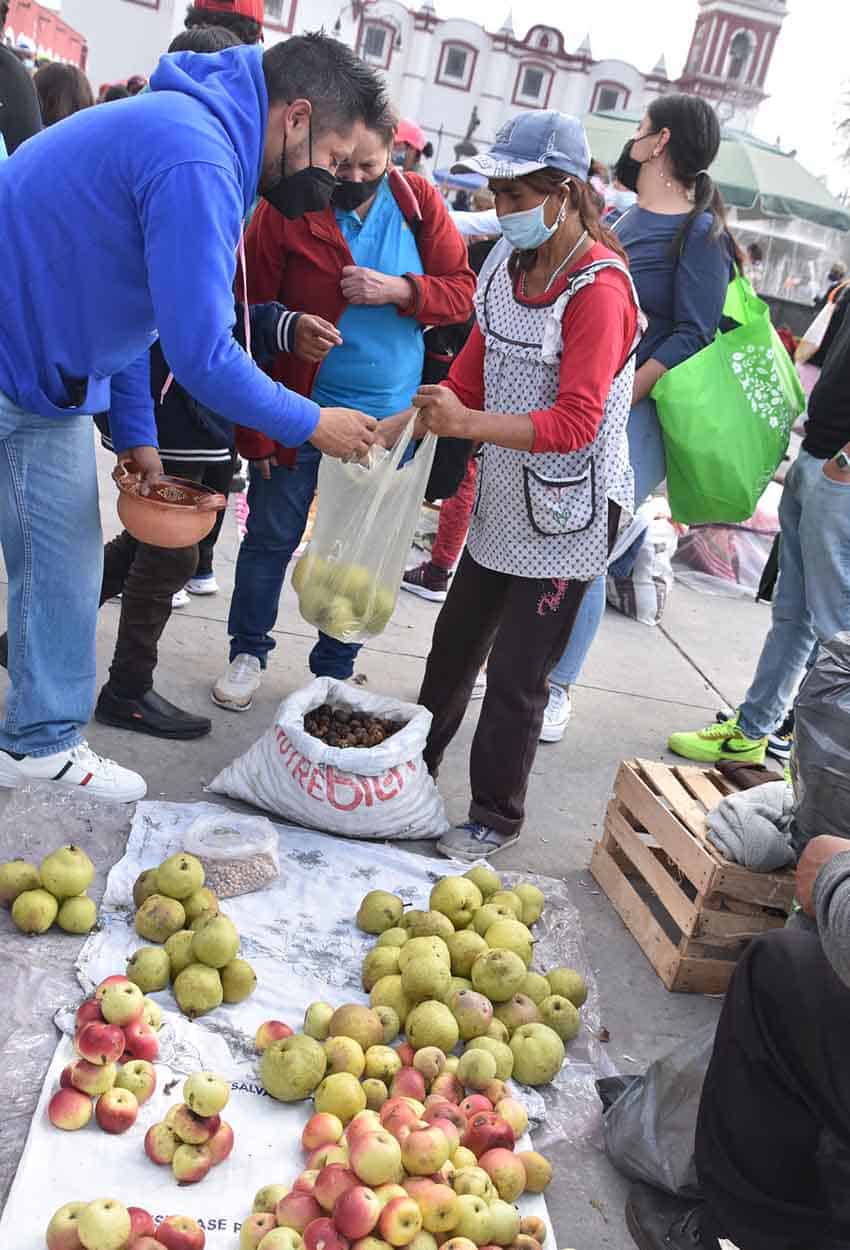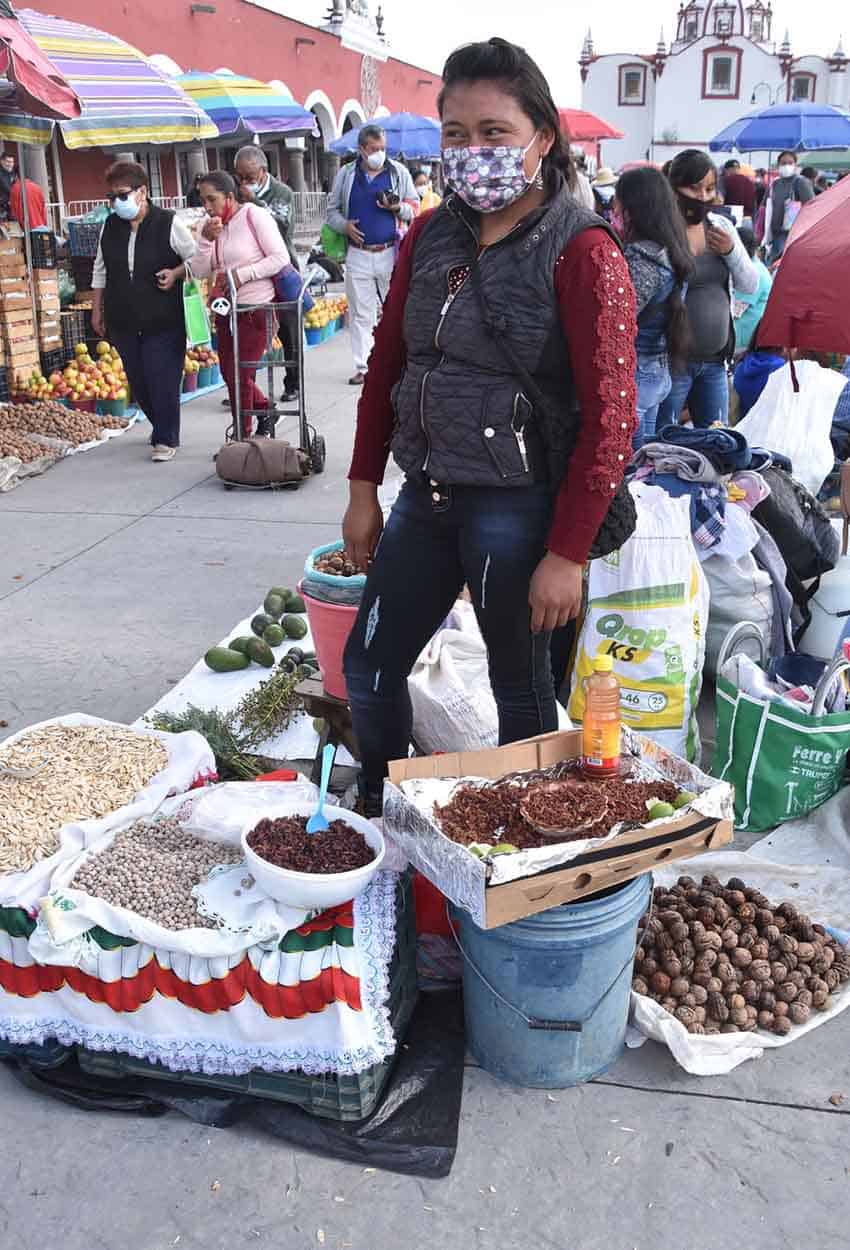Every year on September 7 and 8, the Plaza de Concordia in San Pedro Cholula — one of the two municipalities that makes up the city of Cholula — turns into one large tianguis, the name for traditional Aztec markets.
Tianguis comes from the Náhuatl word, tiyanquiztli, which is translated as “an open-air market.” In Mexico, this type of market is often set up on streets and in parks but only on specific days of the week; typically it’s just once a week. But this particular tianguis only happens once a year.
Cholula is thought to be the oldest continuously occupied city in Mexico and is the site of Tlachihualtepetl, which by volume is the world’s largest pyramid. The tianguis here is believed to be one of the oldest in Mexico, dating back well into pre-Hispanic times, when the city was an important religious and commercial center.
On September 7 this year, the Plaza de Concordia was about half-full of shoppers and vendors selling crafts, produce and a variety of other items. The luscious smell of incense filled the air near some stalls.
Jesús Iván Ríos Pineda and Sandra Villegas Herrera drove four hours from Santa María Chigmecatitlán, a pueblo in the Mixteca region of Puebla that’s famous for making miniature figures from palm leaves.

“The entire pueblo is dedicated to this artesanía [craft],” said Ríos. “There are people who make tiny figures from palm.” He spread an index finger and thumb apart about an inch to show the size. “Whatever figure one wants — a photographer, a doctor — they will make.”
In front of the couple sat figures of animals, baskets and people on bicycles. Some were made from palm, others from strips of plastic. Villegas was making small baskets from the plastic as she sat behind her wares.
Ríos said he can make about a dozen of the bicycle figures in a week, which he sells for 55 pesos each. “We sell at various fairs,” he said. “We move between different pueblos to sell and to survive.”
Because Santa María Chigmecatitlán is so far away and because he wanted to participate in the second day of the tianguis, Ríos said that they would sleep under the arches that ring one side of the plaza.
Adán Jiménez Hernández, from San Miguel Tenextatiloyan, Puebla, which is about a three-hour drive away, was selling his traditional ceramic pots a short distance from Ríos. He’s been coming to the tianguis for 30 years, “ever since I finished secundaria [middle school],” he said.
Last year, the pandemic canceled the event for the first time in its history. This year, Jiménez noticed that there are many fewer clients than in past years.
Before the pandemic, according to vendors, the plaza would have been jammed with people standing and moving shoulder-to-shoulder. Although it was still fairly crowded, officials were limiting the number of people they let in at a time.
On September 7, all items are paid for with cash, but on September 8, the tianguis turns into a trueque, defined as an exchange of goods. On that day, it becomes one large swap meet, a chance for people to barter for goods they want.
While the plaza was only partly filled with stalls and people on the first day, the adjacent parking lot, which had been closed to cars then, was filled on the second. Because of the ongoing pandemic, low metal gates surrounded the plaza this year and there were only two entrances, both manned by municipal officials taking temperatures, doling out hand gel and spritzing people with what was reportedly some sort of sanitizing liquid. Masks were required.
Ríos, who only took cash for his figures on the first day, was willing to exchange for goods on the second.
“It depends on what people bring,” he said. “If they bring beans, I will take that.” He pointed to some colorful flutes he was selling. “I exchanged one small flute for some seeds.”
Concepción Fernández Temich and her husband Santos Popoca García had a stand where they were selling nuts, seeds and vegetables.

“Some people will exchange, some will pay with cash,” said Fernández. She was only looking for certain items. “I will exchange for food but not for things like clothing.”
Popoca said he was willing to consider other things. “Maybe I will exchange for a lamp or games for my grandchildren.”
A woman approached Fernández with several cloths with designs on them that could be embroidered. Fernández looked them over carefully, roughly calculating their worth before deciding to trade for a couple of them with a small bag of her vaina, a long, green vegetable pod. As the woman began to walk away, Fernández handed her an additional vaina.
Cristina Osorio Saloma’s small stand offered seeds, nuts and roasted chapulines (grasshoppers). “I think more people bring things to exchange than pay with money,” she said.
She prefers dispensa (exchange). “I will take clothing for me, for my family, for my children.”
During the trueque, people meandered throughout the plaza, looking over items and offering the ones they brought for exchange. “People can exchange anything: fruits, pots,” said Gabriel Morín. “I brought rice, oil and clothing.” He exchanged some of what he had brought for fruits and seeds.
Víctor Romero Silva was conducting a short survey for Puebla’s Ministry of Culture, and one of the questions was whether people were paying with cash or exchanging goods. “The results show it is about half and half,” he said.
The tianguis, and especially the trueque, are among the things that make San Pedro Cholula special. “This is something unique in Puebla,” said Silvia Zempoalteca, who brought rice and beans to exchange. “I have been coming all my life. It is fun to come and exchange things.”
“People come for tradition,” said Angélica Figueroa, who lives in San Andrés Cholula, the other municipality that makes up the city of Cholula. “That is why I come.”
There’s also a tradition that happens after people leave the trueque. “Many people will buy queso rancho [cheese from the ranch], cecina [dried beef] and nopales, then go home and make tacos with them. It is very common for people to come to the fair, buy these things and then prepare food for their family.”
Although people can bring virtually anything to exchange — bags of rice, cans of beans, clothing — it’s important that whatever is brought is of good quality. For example, used clothing is OK, but badly worn clothing isn’t.
“I think that people, myself included, want to help people in the trueque,” said Figueroa. “So I believe that people bring things that are in good condition. And the exchange should be more or less equal.”
Follow those two simple guidelines and the trueque will be a fun and interesting day (or two) out. And with luck, next year, the place will be jammed once again.
Joseph Sorrentino, a writer, photographer and author of the book San Gregorio Atlapulco: Cosmvisiones and of Stinky Island Tales: Some Stories from an Italian-American Childhood, is a regular contributor to Mexico News Daily. More examples of his photographs and links to other articles may be found at www.sorrentinophotography.com He currently lives in Chipilo, Puebla.
